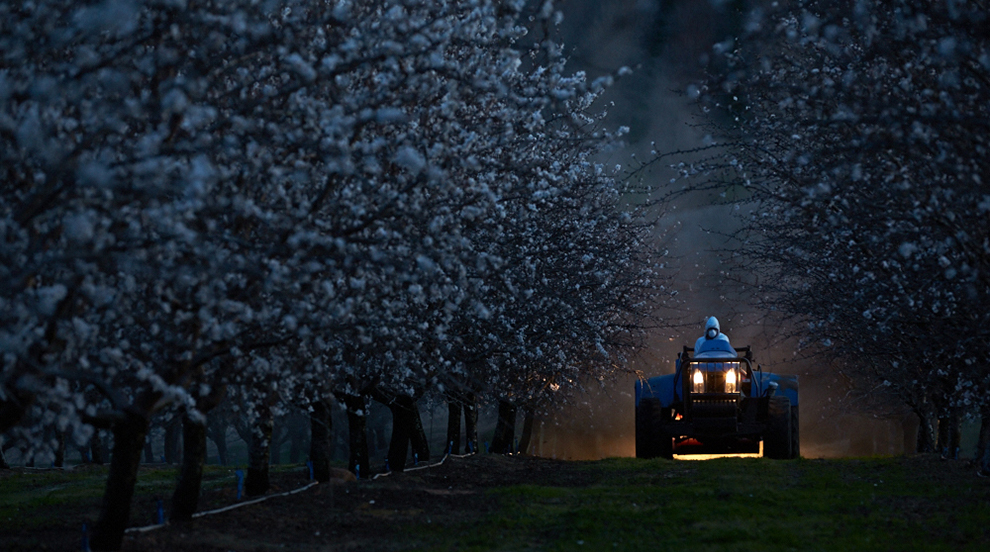During bloom, growers and applicators should make all necessary applications at night to minimize potential exposure of bees and pollen to spray materials, as noted on page 10 of the Almond Board of California’s Honey Bee Best Management Practices.
This year, growers should also consider the State of California’s new safety regulations that went into effect last July, regulations that govern how much lighting is required during nighttime work hours and the kinds of reflective clothing needed to protect anyone working at night1 in an agricultural environment.
A new rule, formally known as the Outdoor Agricultural Operations During Hours of Darkness standard, was developed by the California Division of Occupational Safety and Health (Cal/OSHA) with input from multiple ag industries, including almond growers.
“As with any new regulation it is important for you to take the time to figure out your unique situation and how to integrate this into your operation”,” said Theresa Kiehn president and CEO AgSafe, a Modesto-based nonprofit that has provided practical health and safety education to the agricultural community since 1991.
There are three specific areas within the rule that growers must be aware of:
- lighting,
- personal protective equipment, and
- training
Though she couldn’t recall a specific instance of a night-time worker being injured on the job in the almond industry, there are instances of employees being hurt in other ag sectors by trucks and other equipment inspired the new rules. As such, it’s imperative that growers and applicators not only understand the new rules but also put a plan in place to follow them – a plan that takes into consideration the new required trainings and, at its core, prioritizes employee safety.
Lighting requirements vary by task
Kiehn explained that the new rules include a matrix detailing how much lighting is mandated depending upon the task. She said that lighting is measured in candle feet, which defines the amount of light in a 360-degree circle from where someone is working. Cal/OSHA specifies that light measurements are recorded 30 inches off the ground.
For growers and applicators, some jobs may require 10 candle feet of light while some maintenance duties may specify 20 candle feet of light. A chart showing the lighting specifications may be found on Pages 2 and 3 of this state document.
Kiehn said that lighting can be provided through a combination of stationary lights brought into an orchard, headlights on vehicles and personal lighting such as headlamps on hard hats.
“If you’re a prudent, thoughtful grower, you’re going to buy a light meter and go out and check to make sure the steps you’ve taken to mitigate this risk are working,” she said.
Cal/OSHA has approved the use of light meters provided by three different companies – Davis, SPER and Extech.
Reflective clothing a must
The rule also requires growers to provide workers with any personal protective equipment they need when working at night. Such equipment may include hardhats with lamps or Class 2 high visibility reflective clothing such as shirts, vests and jackets.
Any vehicles that will be used at night – trucks, tractors, forklifts, ATVs and UTVs – must have proper headlights and taillights.
Nightly safety training mandated
Training is a major part of the new night-time regulations. Before each work shift begins, employers are required to ensure that employees know where drinking water is stationed; what areas are designated for hand washing, rest and meal breaks, and parking; and what hazards exist (canals, irrigation equipment, roads, and areas where trucks and equipment might be, as well as their traffic patterns).
Cal/OSHA has the authority to make unannounced inspections of workplaces to see if the new regulations are being followed. Fines start at a few hundred dollars per violation per worker per shift – meaning they could add up quickly for growers out of compliance.
To help growers understand and comply with this new rule, AgSafe created a training video that is available on their website. Also on their site, AgSafe provides growers with forms they can use to document which employees worked each night, when their shifts began and ended, and what tasks they performed.
Growers with further questions should contact Angelina Ceja, AgSafe’s vice president & chief education officer, at Angelina@agsafe.org or (209) 526-4400, ext. 404.
1 “Night” is defined as “after sunset and before sunrise.”


